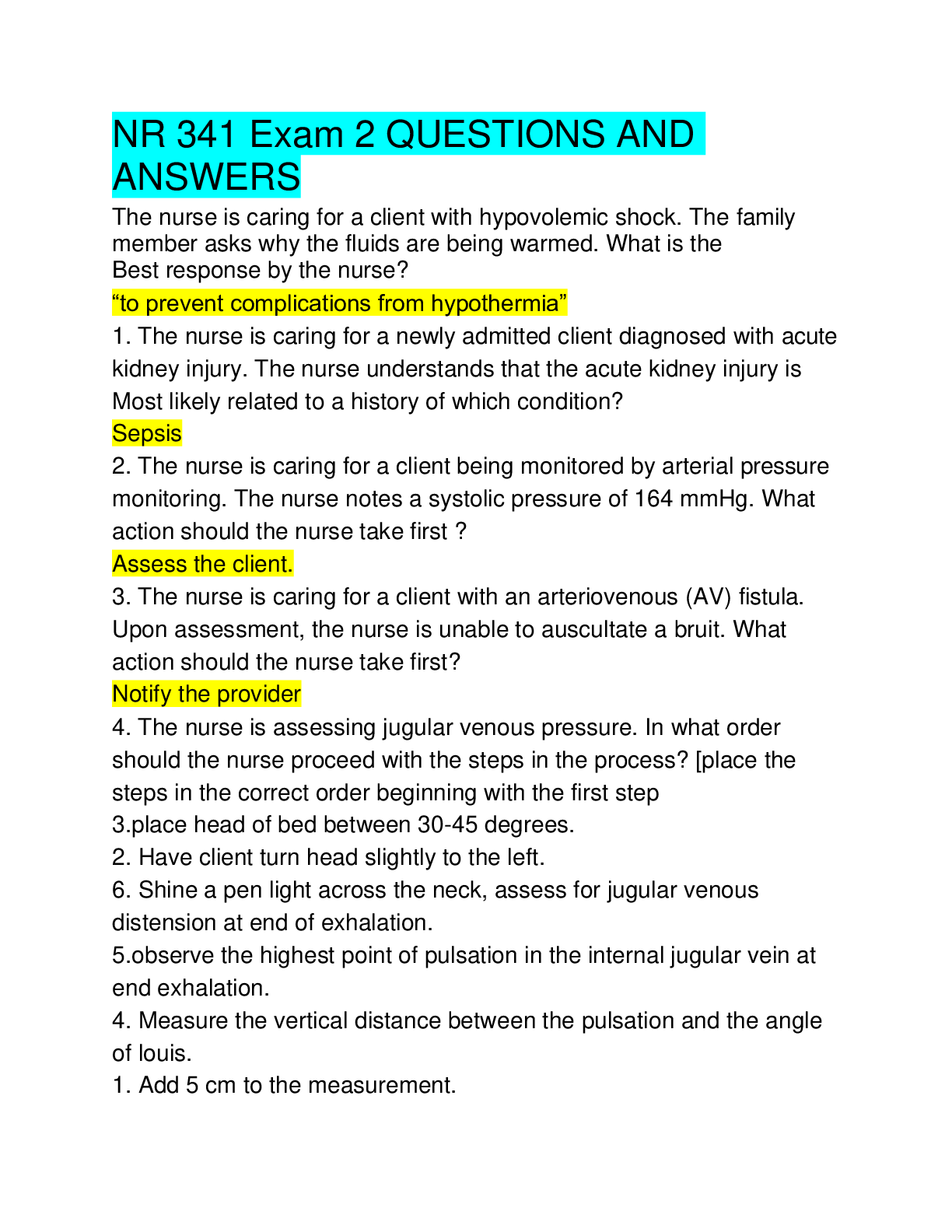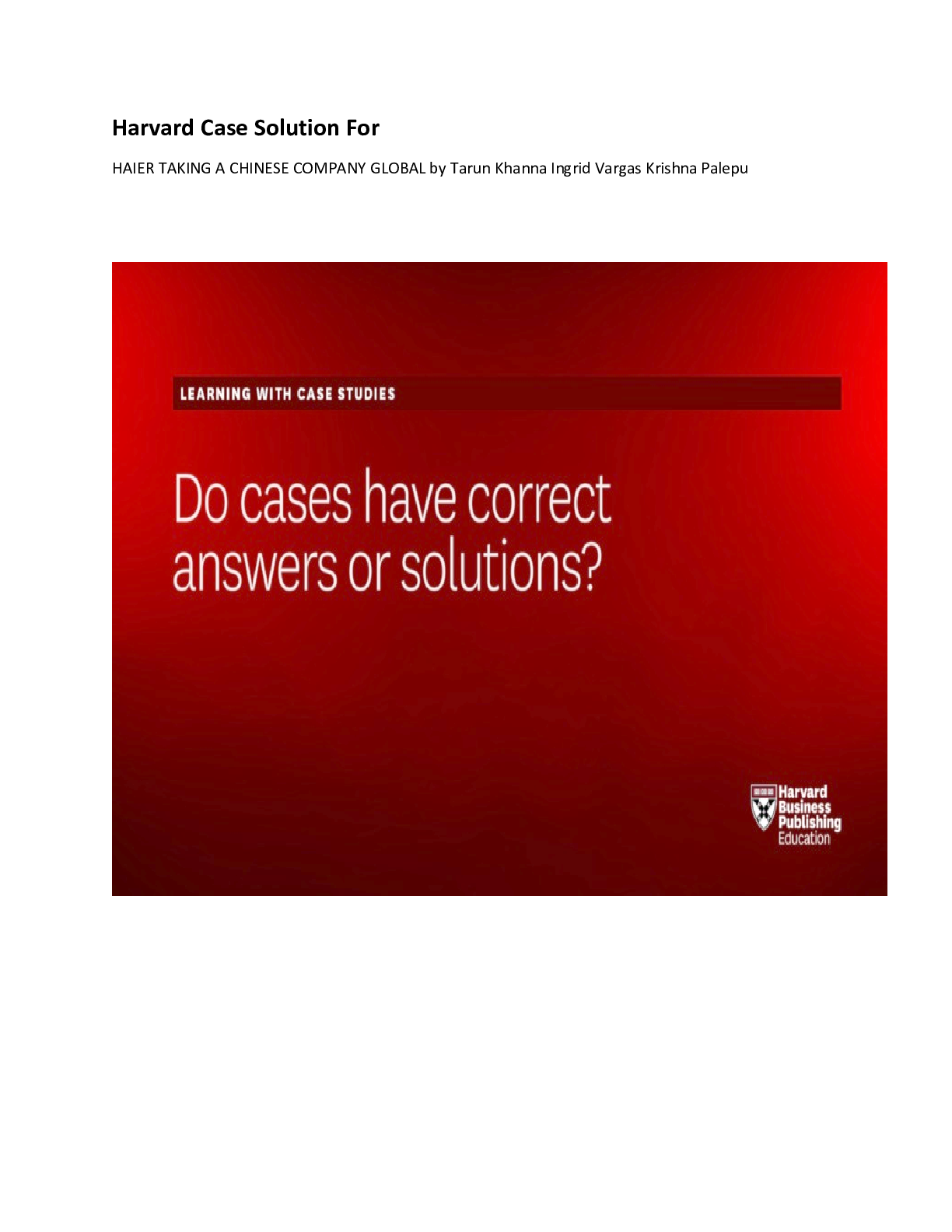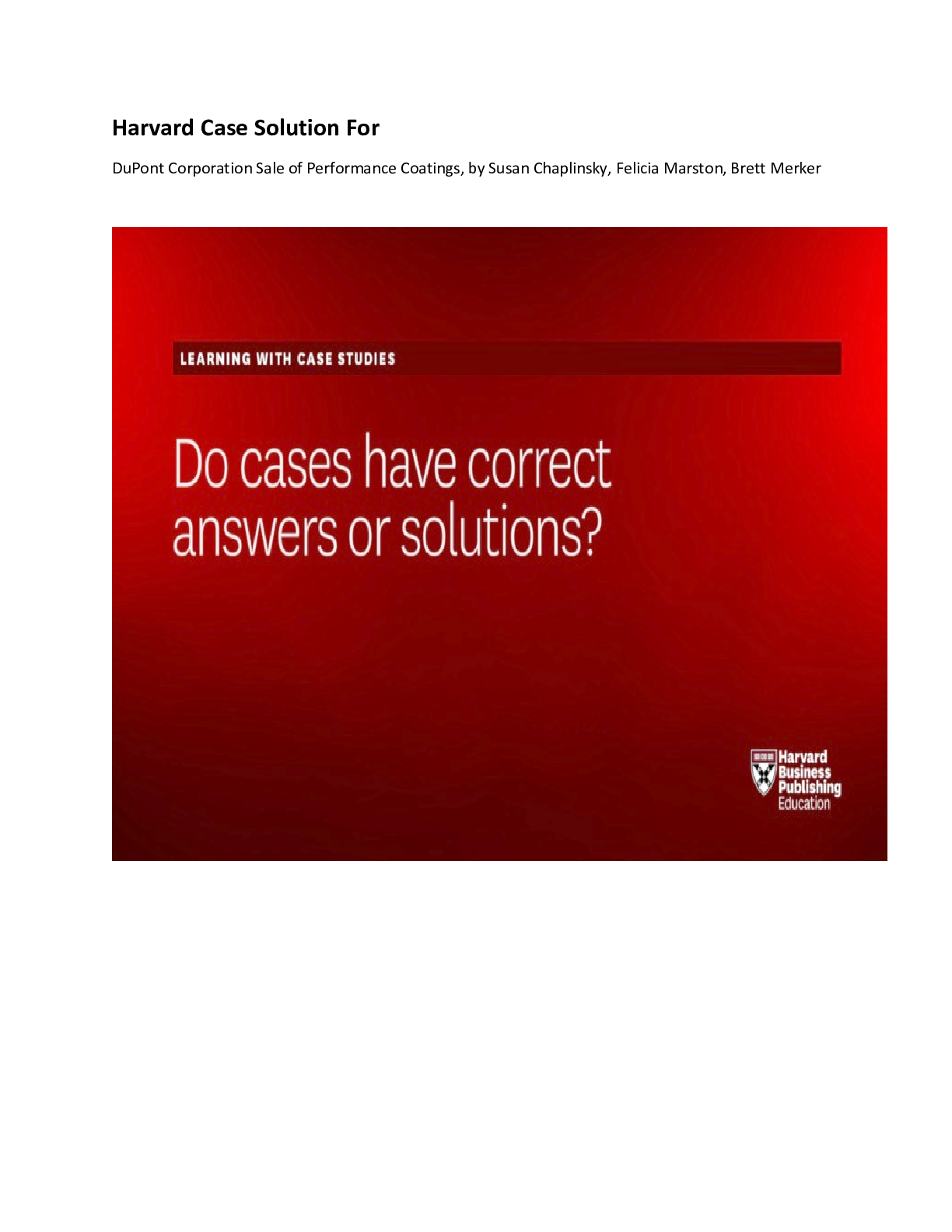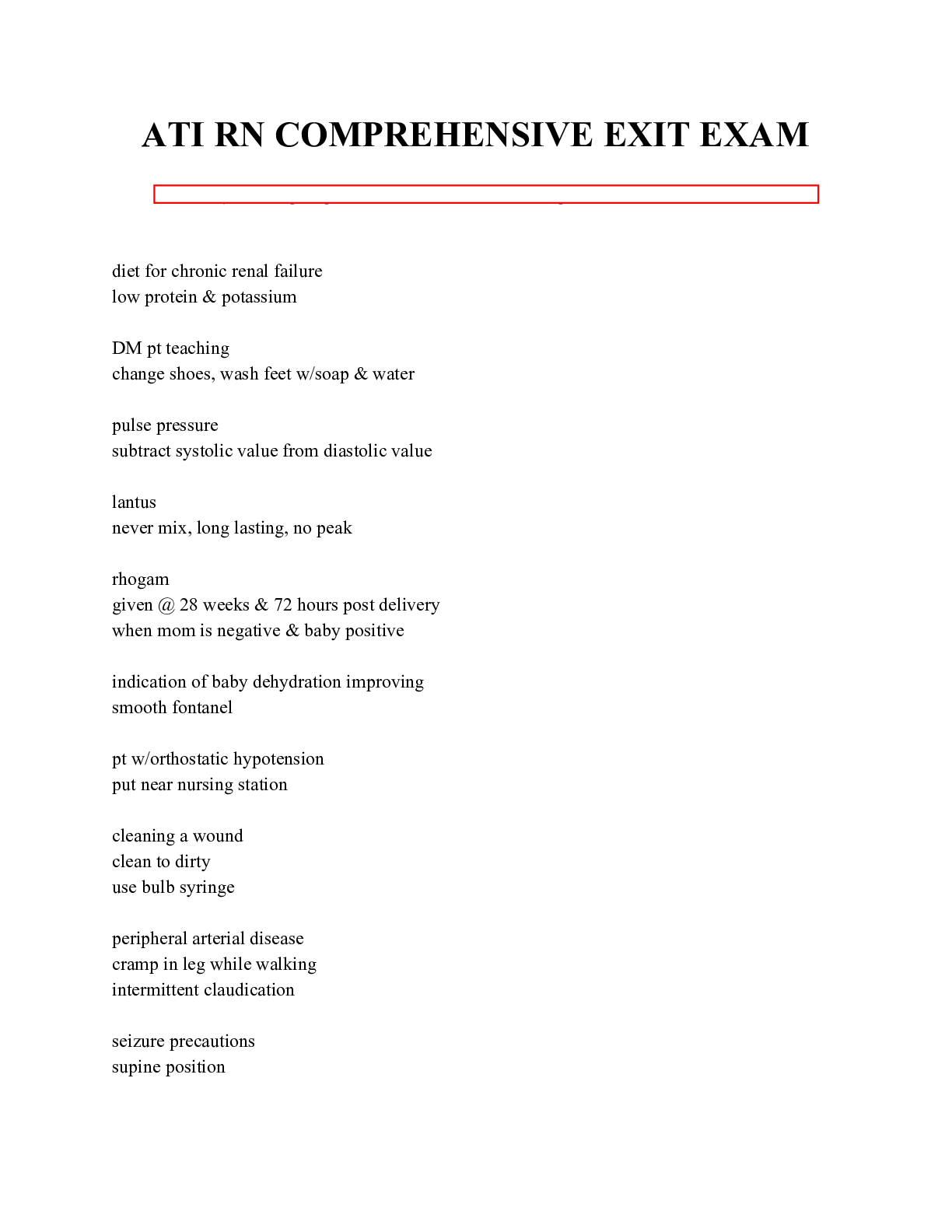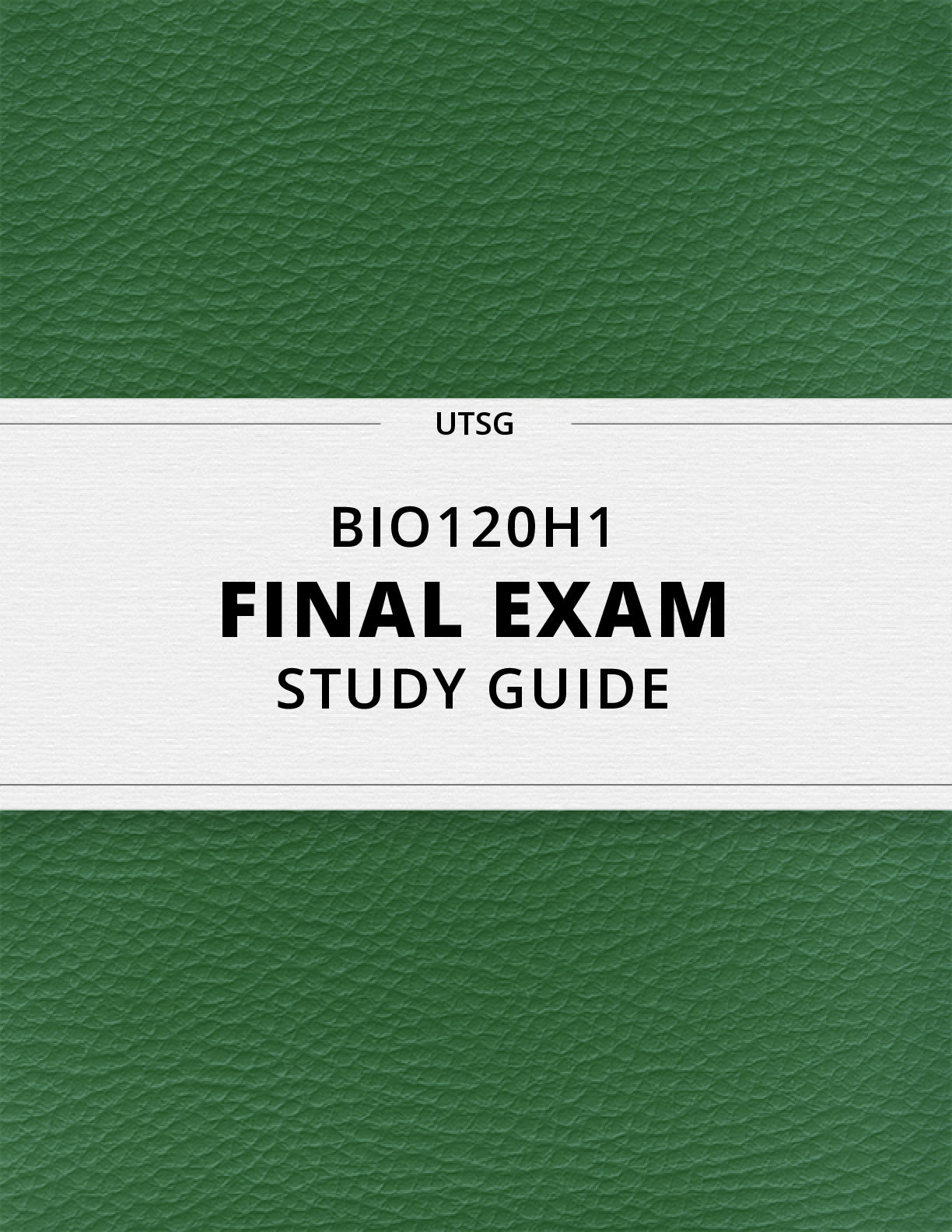Management > EXAM > FINAL EXAM STUDY GUIDE 2 - MGT 521 | COMPLETE GUIDE (All)
FINAL EXAM STUDY GUIDE 2 - MGT 521 | COMPLETE GUIDE
Document Content and Description Below
FINAL EXAM STUDY GUIDE 2 - MGT 521 MGT/521 Final Examination Study Guide This study guide will prepare you for the Final Examination you will complete in Week Six. It contains practice questions, ... which are related to each week’s objectives. In addition, refer to each week’s readings and your student guide as study references for the Final Examination. Week One: Constructing and Supporting an Argument Objective: Identify channels for business communications. 1. An informal communication network is typically called a a. chat network b. chain c. contextual system d. grapevine 2. Which channel of communication is lowest in richness? a. Video conferences b. E-mail c. Memos and letters d. Telephone conversations 3. Jessica needs to describe her vision for an important ad campaign to three of the new team members. What should Jessica do? a. Schedule a meeting b. Send an e-mail c. Write a memo d. Publish a formal report Objective: Evaluate credibility and validity of sources of information. 4. Checking a book’s preface, reading a blurb found on a book jacket cover, and looking for thumbnail biographies at the beginning and end of a source of information are all part of a. evaluating style and tone b. evaluating credentials c. evaluating currency d. evaluating biases Objective: Develop effective arguments. 5. When you write a paragraph based on _____________, the topic sentence should clearly summarize the range of evidence you use a. deduction b. induction c. synopsis d. analysis Week Two: Values and Managing Others Objective: Evaluate alignment of personal values and organizational values. 6. Which developmental method is useful for helping managers to understand their inner feelings and values? FINAL EXAM STUDY GUIDE 2 - MGT 521 a. outdoor challenge programs b. personal growth programs c. mentoring programs d. multisource feedback workshops Objective: Determine strategies to promote collaboration. 7. According to Yukl, the difference between exchange and collaboration as an influence tactic is a. exchange involves personal trade-offs b. collaboration involves a joint effort to accomplish the same objective c. collaboration does not entail problem-solving d. exchange is a motivator whereas collaboration is not Objective: Explain ethical decision making in a complex environment. 8. Which condition is likely to encourage ethical behavior in organizations? a. Strong emphasis on individual productivity b. Cultural values for obedience to authority c. Intense competition for valued rewards d. Cultural values for individual responsibility 9. Which statement about moral development of leaders is correct? a. Moral development occurs naturally as a person becomes older and more experienced as a leader b. Someone at the highest level of moral development will risk social rejection to achieve an important ethical objective c. Most people conform to social norms even if they do not have a strong moral self identity d. The consequences of actions are more important than formal rules and laws for determining whether a person's behavior will be ethical 10. Which of the following questions will help individuals and organizations when deciding if their decisions are ethical? a. Do I feel good about this decision? b. Is it balanced? c. Has it been done before? d. Is there a desirable alternative? Week Three: Introduction to Business Analysis Objective: Explain entrepreneurship versus working for others. 11. Shelby recently started selling her invention: A bed that uses magnetic forces to appear as if it floats in mid-air. Shelby is a. an arbitrageur b. an entrepreneur c. a speculator d. an account manager 12. Kenya recently quit a job with a large corporation to start her own business. While she realizes that her decision comes with risk, she is excited for the chance to be independent and by the challenges of running her own firm. Kenya is an example of a. an intrapreneur. b. an entrepreneur. c. a venture capitalist. FINAL EXAM STUDY GUIDE 2 - MGT 521 d. a raconteur. 13. Which of the following entails the greatest amount of risk? a. Working for the government b. Working for a large business c. Working for a small business d. Starting a business Objective: Identify wants and needs of various stakeholders. 14. Which of the following is a major role of business managers today in meeting the wants and needs of the company’s stakeholders? a. Promoting quality of life b. Balancing the demands for higher salaries and stockholders’ profits c. Outsourcing d. Identifying potential customers Objective: Conduct SWOT Analysis 15. In performing a SWOT Analysis, which of the following would be considered as a threat? a. Falling trade barriers in attractive foreign markets b. Ability to grow due to increased market demand c. Vulnerability to recession and business cycles d. Subpar profitability Week Four: The Business Environment Objective: Conduct benchmarking analyses. 16. Bull's-eye, a regional discount retailer, carefully watches and compares its operation with the operations of its closest rivals. This firm does a. outsourcing b. functional positioning c. core competency ranking d. competitive benchmarking Objective: Explain the basic tenets of managerial accounting and financial accounting. 17. Which of the following is a key step in the accounting cycle? a. Recording information into journals b. Collecting data from customers c. Forecasting expenses and revenues d. Preparing the advertising message Objective: Identify the effects of technology utilization on business. 18. A firm would use data mining if it wanted to a. store copies of crucial data in several different locations to protect against its loss during disasters such as earthquakes, floods, or terrorist attacks. b. protect its data from unauthorized outsiders. c. increase the rate at which information flows through a firm's intranet. d. discover hidden relationships among the data it accumulates. 19. Free trade means FINAL EXAM STUDY GUIDE 2 - MGT 521 a. buyers and sellers contract with each other and offer some goods at no cost b. goods and services can be traded freely across borders without political or economic barriers c. there is no exchange of currency for these products d. there is no exchange of currency, but the trading partners determine the value of the product and perform a bartering process to exchange goods Objective: Identify the effects of globalization on business. 20. Why does it make sense to trade with other nations? a. After producing all the product and service its people want and need, a nation can sell the excess products to the world. b. Some nations have lots of natural resources and technological know-how. They have an ethical obligation to offer the rest to other nations. c. A nation can watch the global market to see which product is bringing the highest price and start producing and trading that product. d. A nation will produce what it can produce most efficiently and effectively and buy from other nations what they can produce most efficiently and effectively. Week Five: Business Overview Objective: Identifying methodologies for adapting different types of businesses to changing markets. 21. Which of the following is true about economies of scale? a. They are available to small firms but not to large firms due to management inefficiencies. b. They are achieved when a firm reduces its average cost of production as it produces more. c. They can be avoided by purchasing supplies and raw materials in large quantities. d. They help explain the success of small businesses. 22. Which of the following correctly identifies the explanation behind the unity of command principle of management? a. Organization design will benefit by the emergence of quick decision-making. b. Organization design will eliminate systems of hierarchy and chains of command due to their hindrance of esprit de corps. c. Organizations that grow will develop several layers of management and the time that it takes to make a decision will increase. d. There will be a significant reduction of work force due to specialization and departmentalization. Objective: Determine the impact of economics on business. 23. For many years, Congressman Ricardo Perez has called for more government regulation of business. "After all," the Congressman said recently, "businesspeople are out to make a profit, not to create jobs or serve their customers. The government must pass more laws to require businesses to take the interests of consumers and workers into account." From these comments, it is clear that Congressman Perez a. agrees with the ideas of Thomas Malthus b. does not accept the “invisible hand” idea brought forth by Adam Smith c. is unaware of the fact that most businesses in the United States are owned by the government d. does not realize that government regulation is already the main determinant of business decisions in capitalist economies Objective: Describe the role of human resource management in achieving business goals. 24. Which of the following is a valid statement about contingent workers? FINAL EXAM STUDY GUIDE 2 - MGT 521 a. An increasing number of companies are hiring skilled professionals such as accountants as part of their contingent workforce. b. Contingent workers are seldom skilled professionals. c. By law, employers must provide contingent workers the same salary and benefits as permanent employees. d. By law, companies cannot hire contingent workers as part of the management team. 25. Which of the following is a challenge that is facing the human resource managers of today? a. Too many unemployed scientists and computer engineers b. An increasing number of Gen Yers in the workforce c. A shift in employee attitudes toward work d. An increased demand for uniformity in benefits offered to employees 26. As part of the HR planning process, the manager begins by assessing the current labor situation at his or her company. Essentially, this means a. preparing job analyses b. preparing job descriptions c. preparing job specifications d. taking an inventory of current employees and their capabilities. Week Six: Business Analysis. Objective: Perform business analyses. 27. During a recession, which of the following statements best describe how a business is affected? a. Prices fall, people purchase fewer products, and businesses fail b. Prices rise and people purchase fewer products c. Living standards tend to remain about the same d. More companies seek globalization 28. A SWOT analysis is conducted and some of the details of the analysis include: many choices for customers, very customer oriented, and repeat customers. These are all examples of which part of the SWOT analysis? a. Threats b. Strengths c. Opportunities d. Weaknesses Objective: Differentiate between strategy and tactics. 29. Which of the following would be considered a strategy? a. Developing short term actions about what is to be done b. Explaining why a company exists c. Determining the major company goals d. Identifying how a company will achieve goals 30. Which of the following would be considered a tactic? a. Setting up work schedules b. Developing budgets c. Determining quality specifications d. Creating performance appraisal FINAL EXAM STUDY GUIDE 2 - MGT 521 1. PROFITABILITY OR RETURN ON INVESTMENT RATIOS Profitability ratios provide information about management's performance in using the resources of the small business. Many entrepreneurs decide to start their own businesses in order to earn a better return on their money than would be available through a bank or other low-risk investments. If profitability ratios demonstrate that this is not occurring—particularly once a small business has moved beyond the start-up phase—then entrepreneurs for whom a return on their money is the foremost concern may wish to sell the business and reinvest their money elsewhere. However, it is important to note that many factors can influence profitability ratios, including changes in price, volume, or expenses, as well as the purchase of assets or the borrowing of money. Some specific profitability ratios follow, along with the means of calculating them and their meaning to a small business owner or manager. 2. LIQUIDITY RATIOS Liquidity ratios demonstrate a company's ability to pay its current obligations. In other words, they relate to the availability of cash and other assets to cover accounts payable, short-term debt, and other liabilities. All small businesses require a certain degree of liquidity in order to pay their bills on time, though start-up and very young companies are often not very liquid. In mature companies, low levels of liquidity can indicate poor management or a need for additional capital. Any company's liquidity may vary due to seasonality, the timing of sales, and the state of the economy. But liquidity ratios can provide small business owners with useful limits to help them regulate borrowing and spending. Some of the best-known measures of a company's liquidity include: FINAL EXAM STUDY GUIDE 2 - MGT 521 LEVERAGE RATIOS Leverage ratios look at the extent to which a company has depended upon borrowing to finance its operations. As a result, these ratios are reviewed closely by bankers and investors. Most leverage ratios compare assets or net worth with liabilities. A high leverage ratio may increase a company's exposure to risk and business downturns, but along with this higher risk also comes the potential for higher returns. Some of the major measurements of leverage include: [Show More]
Last updated: 2 years ago
Preview 1 out of 7 pages

Buy this document to get the full access instantly
Instant Download Access after purchase
Buy NowInstant download
We Accept:

Reviews( 0 )
$12.00
Can't find what you want? Try our AI powered Search
Document information
Connected school, study & course
About the document
Uploaded On
Feb 16, 2021
Number of pages
7
Written in
Additional information
This document has been written for:
Uploaded
Feb 16, 2021
Downloads
0
Views
54


